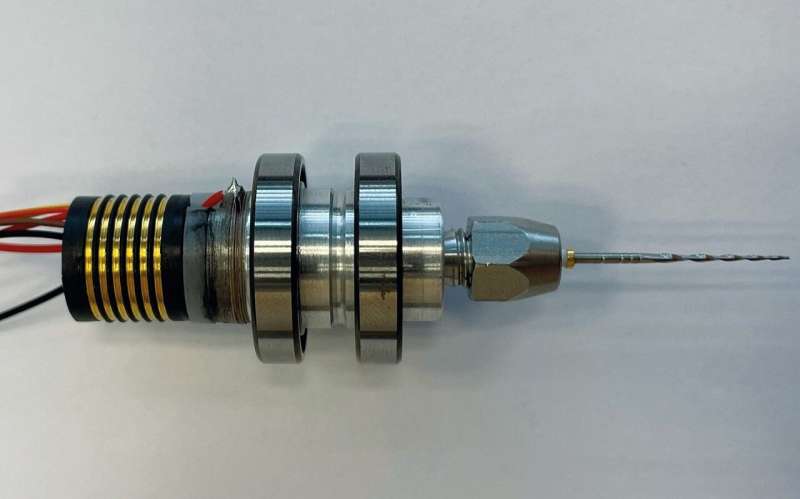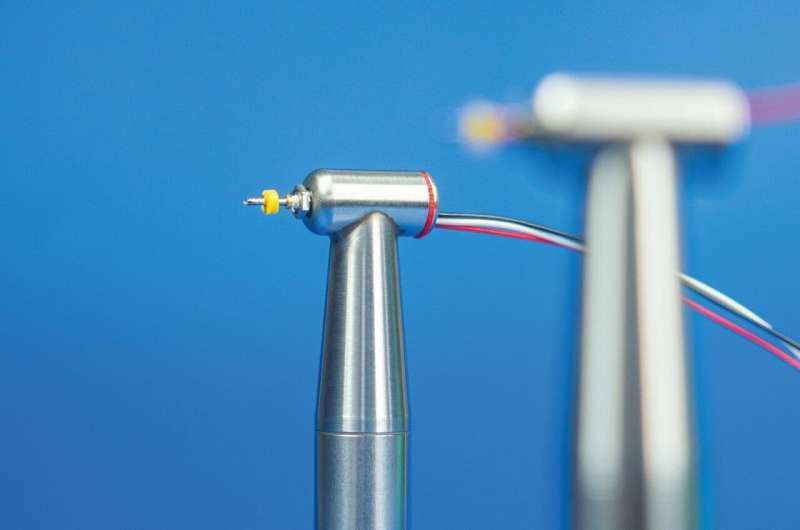This article has been reviewed according to Science X's editorial process and policies. Editors have highlighted the following attributes while ensuring the content's credibility:
fact-checked
trusted source
proofread
Piezoceramics help shorten root canal treatments

When carrying out root canal treatment procedures, dentists need to insert a file deep into the root canal to remove the inflamed tissue. The rotating file often gets jammed and must be cleaned regularly.
Researchers at the Fraunhofer Institute for Ceramic Technologies and Systems IKTS have now developed a piezoceramic stack actuator that overlays the rotating motion with a vibrating motion. The file does not get jammed as often, meaning that procedures on patients can be completed faster. This technology is also useful for other medical applications, for example in diagnostics and cancer treatment.
Fraunhofer IKTS will present a demonstrator at the joint Fraunhofer booth at the COMPAMED medical engineering trade show in Düsseldorf (Hall 8a, Booth G10).
A new development of the Fraunhofer Institute for Ceramic Technologies and Systems IKTS will be of interest to anyone who has experienced root canal treatment. The procedure is often necessary if a patient has a deep cavity, and the roots of the tooth have become inflamed. To save the tooth, the dentist opens it up and removes the inflamed tissue inside the root canal using a rotating file. Even when local anesthetic is used, the procedure is exhausting and stressful for patient and dentist alike. This is partially due to the fact that the tissue removed from the root canal sticks to the file and jams it.
As part of the IPUCLEAN (intelligent piezoelectric ultrasonic system for improving the cleaning and cutting capacity of nickel-titanium alloy root canal files) joint research project, researchers at Fraunhofer IKTS in Dresden have created an innovative file that reduces the workload of the dentist and shortens procedure times. To achieve this, under the leadership of Dr. Holger Neubert, department head of Smart Materials and Systems, the team developed a tiny piezoceramic stack actuator that overlays the file's rotation with axial vibration in the ultrasonic frequency range.
A dental file that rotates and vibrates
A standard dental file rotates around 200 times per minute under the power of an electric motor in the handheld device. It is inserted into the root canal and periodically removed and reinserted. Part of the tissue removed ends up as a sticky mass attached to the file, which reduces its cleaning ability and places strain on the tool. Even though these dental files are made from a superelastic nickel-titanium (NiTi) alloy, there is an increased risk of the files breaking when they are under stress. Because of this, they constantly need to be removed and thoroughly cleaned.
Neubert explains the advantages that using the piezoceramic stack actuator offers: "By overlaying the rotation with axial vibration, the file gets clogged less quickly, meaning that it doesn't need to be cleaned so often. Dentists are then able to concentrate much more on their complex work in the root canal. The risk of the file breaking is also reduced." For patients, this means that their root canal treatment is over much faster.

Fast, small and effective: Piezoceramic stack actuators
"The core idea of combining the two motions of the dental file came from the specialists at the Department of Dentistry at the Rostock University Medical Center. We used piezoceramic stack actuators as the drive element because they are most able to meet the special requirements for vibration amplitude and frequency, size as well as supply voltage," explains Neubert. Gebr. Brasseler GmbH & Co. KG coordinated the IPUCLEAN project. Dentists at the Department of Dentistry at the Rostock University Medical Center have already trialed the technology on artificial teeth, which resulted in positive feedback.
Piezoceramic-based actuators offer many advantages. They are small and compact, work quickly and precisely, are easy to control and lose minimal heat. Stack actuators consist of several layers stacked on top of one another that work together to increase the actuator's displacement. Because of this, the IPUCLEAN project scientists were able to make the handheld device small enough to easily fit into the narrowest spaces in patients' mouths. Another advantage is that Fraunhofer IKTS have constructed the stack actuator from lead-free materials. This already fulfills future requirements of the European RoHs Directive and means that the device is free from harmful substances.
Further medical engineering applications
Fraunhofer IKTS is leading the way in unlocking the huge potential of piezoceramic materials. Researchers are looking into further medical applications for the technology, particularly low-frequency ultrasonic transducers with high penetration depth for tomography. These piezoceramic transducers have been compacted so much that it is possible to fit 2,000 of them in a conventional-sized tomography system. This enables high-resolution 3D imaging of the human body for diagnostics.
High-frequency ultrasound transducers are in high demand for dermatology, among other fields. They provide precise, high-resolution images at low penetration depths. Possible applications also extend to high-performance ultrasonic transducers. These will use extremely focused sonic input to destroy specific areas of tissue, for example in cancer treatment.
"Piezoceramic components can be used in a wide array of applications and, thanks to their compactness and performance, are ideal for medical engineering. We are able to develop custom solutions to suit the needs of individual clients," Neubert says.


















